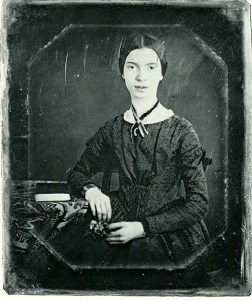A summary of a classic Dickinson poem by Dr Oliver Tearle
‘Pain — has an Element of Blank – ’ is a short poem by Emily Dickinson which, like ‘It was not Death, for I stood up’, treats the dark subject of mental and physical pain and the way it engulfs our lives, extinguishing everything else.
Pain — has an Element of Blank —
It cannot recollect
When it begun — or if there were
A time when it was not —
It has no Future — but itself —
Its Infinite realms contain
Its Past — enlightened to perceive
New Periods — of Pain.
When we are ill or in pain it is very difficult to remember a time when we weren’t ill or in pain. The visceral power of physical pain – but this might also be extended to psychological pain as well – prevents us from imagining or envisioning a time without it, whether in the past or the future. This, in summary, is a short paraphrase of the meaning of ‘Pain has an Element of Blank’.
 As T. E. Hulme would later highlight with his distinction between romanticism and classicism in poetry and art, poetry can often be too concerned with the infinite and with ‘big’ things, and can also stray into the realms of emotional excess.
As T. E. Hulme would later highlight with his distinction between romanticism and classicism in poetry and art, poetry can often be too concerned with the infinite and with ‘big’ things, and can also stray into the realms of emotional excess.
This is especially true when talking about things like pain: how can a poet do so without lapsing into self-pity? One way is to ignore the ‘self’ altogether and instead focus firmly and squarely on pain itself. This is what Emily Dickinson does in ‘Pain has an Element of Blank’, personifying pain as a sentient being and downplaying or displacing the person – whether it’s the poet herself or someone else – who experiences the pain. It also underscores the way that pain seems to take over our identity so that we become the pain we are experiencing.
The other effect of this decision is to highlight how universal pain is: we all experience it at some point. And ‘universal’ seems like the right word here:
It cannot recollect
When it begun — or if there were
A time when it was not —
This is like another impersonal thing, the universe itself, which may not have ‘begun’ but be infinite, so that the universe in which we live is merely the latest in a long line of new universes which are expanding and contracting, or collapsing and then exploding, for all of time. It, too, has ‘Infinite realms’.
Yet no sooner has Dickinson presented pain as a thinking entity than she denies it the ability to think it all: ‘It cannot recollect / When it begun’, she tells us, with the impersonal pronoun ‘It’, along with the negation of any ability to recall its origins, calling into question pain’s ability to remember when or how it started. In other words, pain is offered to us as an almost human entity, but only so Dickinson can remind us that when we are in the grip of pain we lose our ability to remember, in this case remember a time before the pain.
Pain seems infinite even though we know it is not: death, if nothing else, puts an end to it. But the idea of ‘New Periods – of Pain’ suggests that pain is merely cyclical, and that it will come round again, a message that is neatly exemplified by the fact that Dickinson begins and ends her poem with the word ‘Pain’.
In the last analysis, ‘Pain has an Element of Blank’ is about the seemingly endless cycle of pain in which he feel ourselves to be trapped when in the grip of it. Pain becomes all-consuming and as big and infinite as the universe – but it is also not peculiar to us, for it is universal, too.
If you want to own all of Dickinson’s wonderful poetry in a single volume, you can: we recommend the Faber edition of her Complete Poems. Discover more about her poetry with ‘The Heart asks Pleasure first‘, ‘That it will never come again‘, and ‘I felt a Funeral – in my Brain‘.
The author of this article, Dr Oliver Tearle, is a literary critic and lecturer in English at Loughborough University. He is the author of, among others, The Secret Library: A Book-Lovers’ Journey Through Curiosities of History and The Great War, The Waste Land and the Modernist Long Poem.


Reblogged this on Greek Canadian Literature.
Great analysis, as always. I love and envy her precision with words.
Thank you! She has a unique style and is brilliant at taking ‘big’ ideas and expressing them in a new way :)
If you want to see some ‘close analysis’ of Dickinson log on to Mod Po the free Coursera course from the University of Pennsylvania. The Profs sit round a table and their debate is videoed!